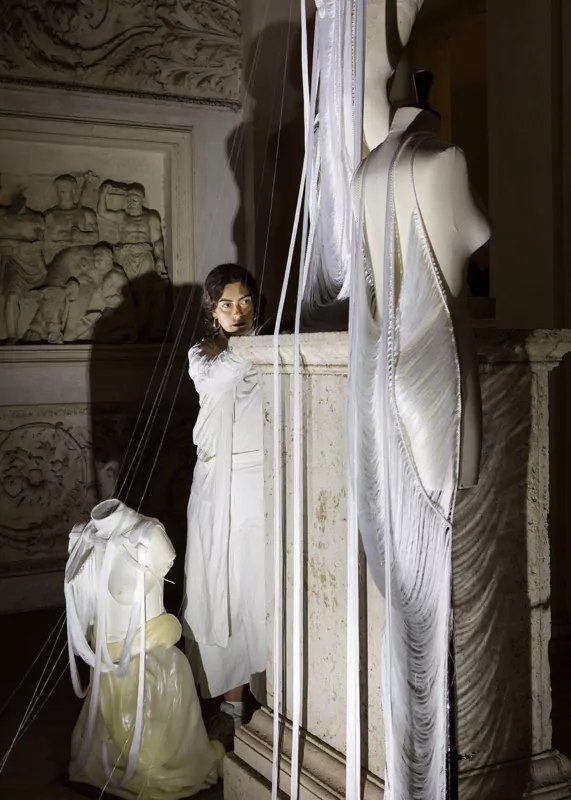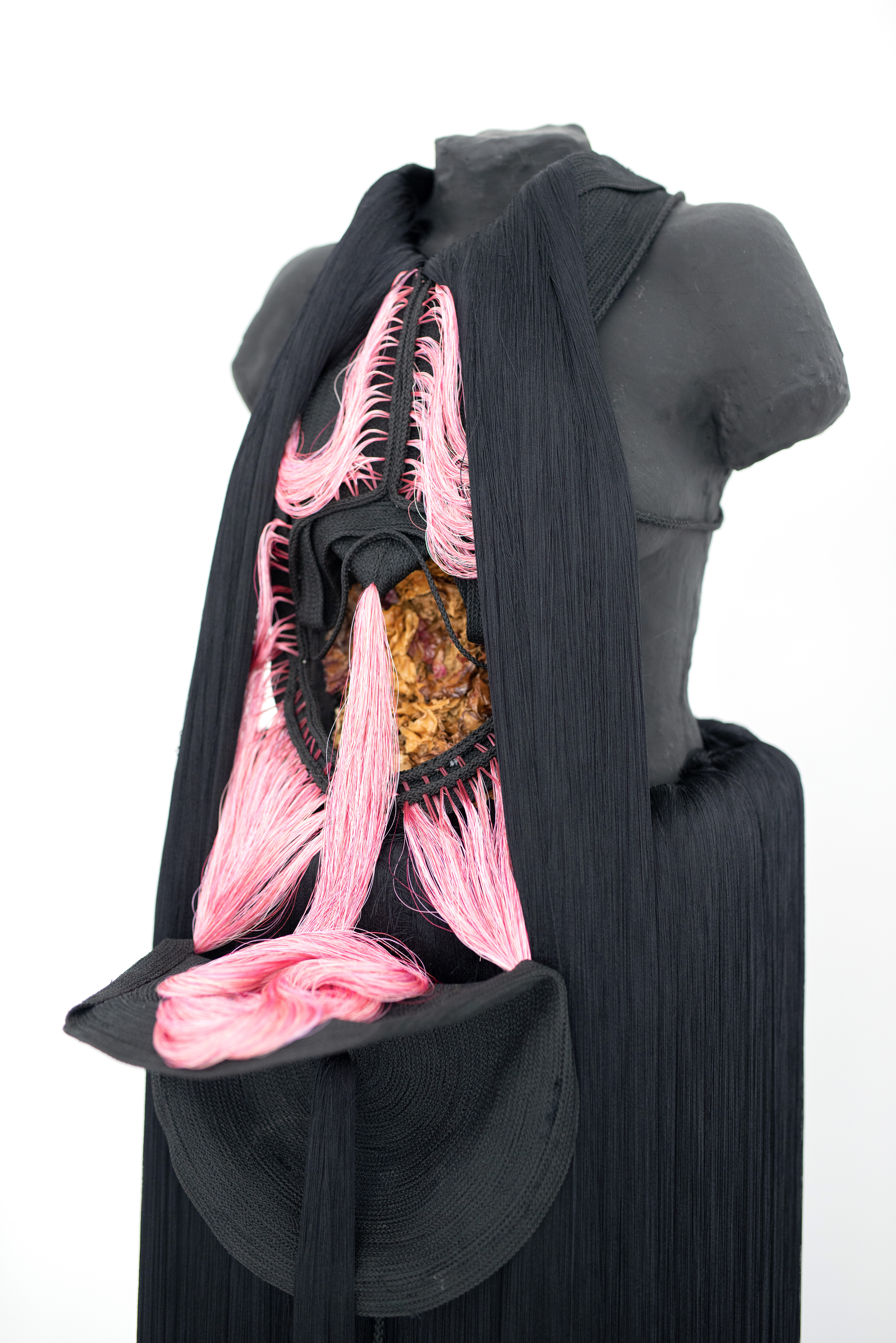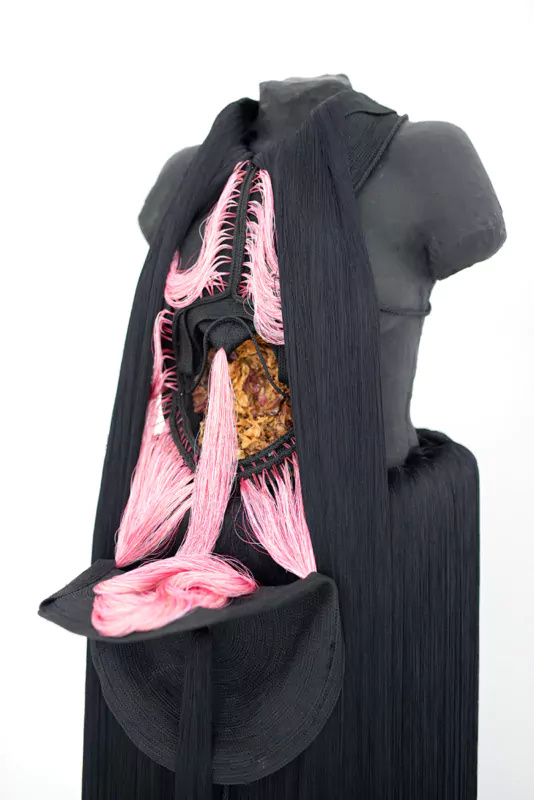
Sculpture as epidermis, clothing as organ: a conversation with Jeanne Vicerial
Interview
Art historian Ida Soulard interviews Jeanne Vicerial on the origins and evolution of her practice. Their conversation takes in her research work in fashion design and her relationship to the body, her beginnings in sculpture, her commitment to digital craft and the importance of the collaborative process.
IS: You recently completed a major project entitled Clinique Vestimentaire, comprising the defence of your doctoral thesis (2019) and an exhibition at the Magasins Généraux (2021). You inaugurated a textile work at the crossroads of fashion, design and contemporary art, borrowing from the vocabulary of anatomy and medicine. Can you tell us how Clinique led you to this exhibition, ‘Armors’ (Templon Paris, 2023)?
JV: Clinique Vestimentaire is a project that stretched over eight years. It started with my degree at the École des Arts Décoratifs and ended with the exhibition at the Magasins Généraux, which was an obvious prolongation of my PhD work. The pieces and ideas flowed naturally from this project to the exhibition. Sculpture is another form of writing and reading, one that suits me better.

IS: How did you come up with the idea of producing woven sculptures?
JV: I spent a year in residence at the Villa Medici in Rome in 2019–20 and that was where I started wanting to make my own sculptures. I originally had the idea of studying male bodies and clothing, but when I looked at the sculptures in the park there and saw the Venuses with their wet drapery, the representations of women in lascivious postures with draped cloth that always seems to be accidentally slipping off, I decided to focus again on the female body. I started by copying in 3D the bust of a Venus that was in the loggia known as Cleopatra’s loggia, laid out by Cardinal Ferdinando de’ Medici, and I worked on my costume-sculptures in the studio before doing two fittings with the real sculpture and taking a series of photographs of that.
Then, during the lockdown, I had only my body to work with. So, in collaboration with the photographer Leslie Moquin, who was also at the Villa, I produced a series of forty photographic self-portraits titled Quarantaine Vestimentaire. These were costumes and masks, a “lockdown spring- summer collection” made with flowers from the Villa’s garden with the active blessing of the gardeners. I posted one a day on Instagram. It was at the Villa that photography and lens-based images became a more important part of my work. Little by little, I moved into the realm of art. The exhibition Présences, at the Templon gallery in Brussels (2022), still showed traces of the fashion world. I had conceived part of the exhibition as a “static fashion show” of sculptures, with music composed specifically by Marco Paltrinieri, who imagined what the soundtrack of such a show might be. The dressmaker’s dummy was less and less identifiable, but the pieces remained in transition, wearable: clothing sculptures. In the ‘Armors’ exhibition, these traces have disappeared; it is as if the dressmaker’s dummy had been eaten by the sculpture.

IS: You work with bodies that are almost exclusively female or genderless (presences, armors). There is also this idea of bringing the interior to the exterior: viscera, organs, but also fluids, through the appearance of pink threads. You highlight what we usually try to hide by giving it the status of a cosmic ornament. Could it be said that there is a deliberate feminist commitment in your work?
JV: That’s for sure, but I don’t want to reduce the discussion to the female body. I am thinking more generally about the transformation of bodies, trying to include all types of bodies in transformation.
From a fashion point of view, for too long bodies have been trying to fit into clothes, even going so far as contemporary surgery. In my fashion work, I was interested in designing clothes that fit real bodies, not the other way around. Here I am working with bodies that follow the canons of haute couture, but they are impossible canons, and bodies that do not exist, literally alien. Here I lengthen them even more, intensifying their strangeness. It seems to me that while scientific representations of the stages of body modification, be it abortion, pregnancy, childbirth, or any kind of male/female or non-binary transformation, are tolerated when they allow for the management and control of bodies, these events meet with a kind of artistic hostility. I do not conceive of the human body as having an a priori identity to which one must conform, but as a fibered space that is permanently mutating.

IS: The works you make are highly technical, based on meticulous craftsmanship, and they also take a long time to produce.
Alongside this extremely precise manual work, there is also a machine: a robotic arm that weaves autonomously. This reminds me of the defence of handicraft by weaving artists of the early 20th century, such as Anni Albers (1899–1994), for whom manual work was a means to better engage with industry. It made it possible to regain degrees of lost freedom. What is your relationship to manual work, industry, and robotics?
JV: Each piece in the exhibition is entirely handmade and requires between 600 and 1,200 hours of work. The installation, preparation and “styling” time is also very long. There are quite a few of us in the workshop, because we need a solution to make more of the time available. It is important to understand that none of the pieces in the exhibition were produced with the robotic arm. That represents the research part of my work. It is a robot that was originally made to pack boxes in a warehouse and that here was chosen to dance. It works at 5% of its capacity and is also the soundtrack for the upper part of the exhibition. It is important for me to integrate an element of digital craft and to mix craft, design and art in the same space, without any difference in degree or value.
When you are a costume designer or a technician, you are not given the same kind of respect as an artist. But I want people to be able to question the way things are produced.

IS: Your sculptures have a quality of movement and their installation proposes a different type of dramaturgy each time. You have collaborated with performers for their activation at the Magasins Généraux, and in Brussels with a perfumer and a musician. This is total sensory work. You also designed the costumes for Angelin Preljocaj’s opera Atys, for Hervé Robbe’s Sollicitudes, and the costume for the performance Figures by the choreographer Dalila Belaza. How do you see the action of textile sculpture at the heart of these different modes of collaboration?
JV: I like the idea of sculptures in motion and working collaboratively. Each exhibition tells a story of protection that is reconfigured each time. In the context of producing costumes for the choreographers you mention, I feel it is important that the costume goes beyond its traditional function as a prop to become a material–character and that it has a structuring role in the dramaturgical construction. The design of the clothing sculptures for Sollicitudes, which was my first collaboration of this type, was seminal, because it was carried out in a real process of co-construction.
I am only at the beginning however, and I would like to be able to develop this aspect further. In my work, I regularly invite collaborators to develop certain aspects with me. This is the case with Louise Ernandez who directed the film, the three musicians who produced the soundtrack in the form of a musical exquisite corpse, and the performers with whom I conceive the activation of certain pieces. I like the idea that the spectator should come and have an experience. It was, for example, with this idea in mind that I developed a perfume for the sculptures with Nicolas Beaulieu. The first, PH 6.3, synthesises the average PH of the skin and is the scent of a clean body. The second, Étude Vénus n°1, concentrates the smell of a flower, from bud to wilted flower. The experience is visual, olfactory, and aural.
IS: What projects are you working on currently?
JV: I have several, notably intensifying the links between music and sculpture. I am thinking of creating an “album of sculptures”, a series of musical pieces produced by invited musicians that would allow me to compose a sound vocabulary for the “voices” of the sculptures. I am also developing with Nadine Schütz (sound artist) and Julia Cima (choreographer, dancer and fasciatherapist) a project of performances and sculpture- instrument between the work of sewing, music and the body. These are two long term projects. Otherwise, we are producing, with Nicolas Beaulieu, a new perfume, Armoressence, which will soon be launched in partnership with the magazine Nez.

_
Jeanne Vicerial, Fondation Thalie, Arles (France), from July 2023.
Ida Soulard is an independent curator, PhD in art history (ENS PSL Paris, Sacre), and a teacher (ENSA Bourges, France).
This text includes excerpts from the original interview published in the catalog Armors, (TEMPLON, 2023).
Born in 1991, Jeanne Vicerial lives and works in Paris. Her passion for clothes design began when she was a teenager. After studying costume design then obtaining a master’s in clothes design at the Paris École des Arts Décoratifs in 2015, she started a research project which resulted in a Sciences, Arts, Creation and Research PhD. Her thesis, defended in 2019, questions the mechanisms at work in the design of contemporary clothing and proposes an alternative to the made-to-measure/ready-to-wear dichotomy associated with fast-fashion culture.

